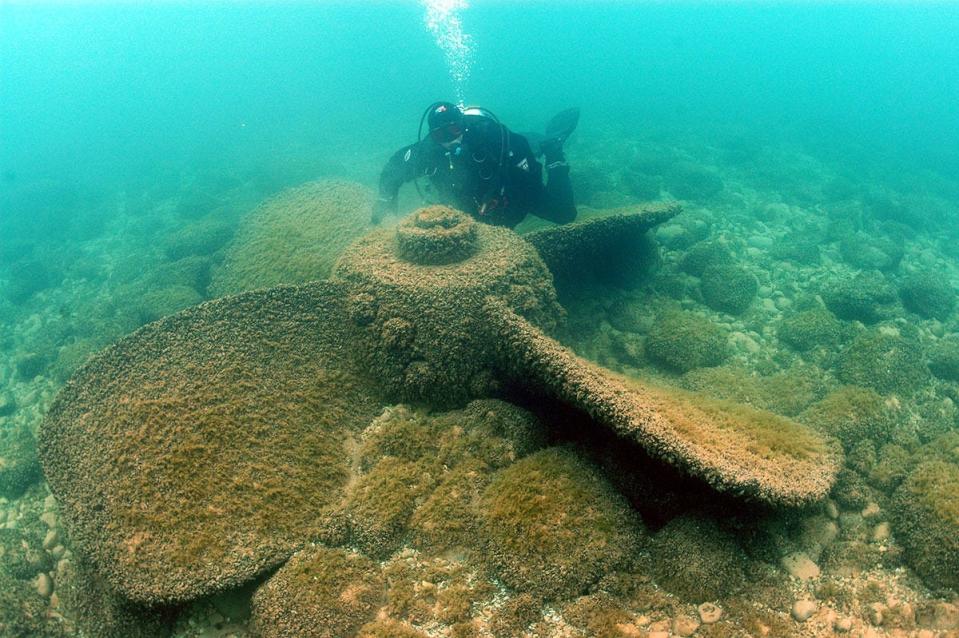7 Wisconsin shipwrecks you can dive to in the Great Lakes
Nearly 800 shipwrecks in Wisconsin lakes and waterways have been catalogued by the Wisconsin Historical Society Maritime Preservation Program and the University of Wisconsin Sea Grant Institute on WisconsinShipwrecks.org.
With the right equipment and skills, it is possible to visit several of them. Many have become popular tourist attractions for curious scuba divers, snorkelers, kayakers and boaters.
Here's how to visit seven of Wisconsin's historic shipwrecks.
More: How many shipwrecks are in Lake Michigan, and what happens to them?
Three shipwrecks are clearly visible from the shore in Sturgeon Bay
The remains of the Empire State, Ida Corning and Oak Leaf are easily accessible to divers, snorkelers, kayakers and even pedestrians at Bullhead Point City Park on the west side of the Sturgeon Bay in Door County. A historic marker provides information about, and points out, the wrecks.
The three 19th-century wooden barges were abandoned and burned to the waterline at Bullhead Point in 1931 after there was no longer a use from them due to the Great Depression. The ships were last owned by the Sturgeon Bay Stone Company and used to transport limestone.
According to Wisconsin Shipwrecks, the three shipwrecks sit in zero-to-10 feet of water, very close to shore, and are thus easily visible, especially when the water level is low. Due to the burning and now weather, ice and the ships' shallow resting place, the wrecks have faced wear and damage over the years. Archaeological research by the historical society and East Carolina University's Program in Maritime Studies has been used in preserving them.
The Louisiana off Washington Island is great for beginner divers
The Louisiana, a wooden freight steamboat built in 1887, was ravaged by a severe snowstorm and a fire in November 1913. The ship's wreckage lies near Schoolhouse Beach on Lake Michigan's Washington Harbor, just off of Door County's Washington Island.
At the time of its sinking, the Louisiana was returning from carrying coal from Ohio to Milwaukee. Luckily, no one on the Louisiana died in the shipwreck, but the storm that sunk the ship also wrecked 20 Great Lakes ships, damaged 71 more and drowned 248 sailors, Wisconsin Shipwrecks says.
According to Wisconsin Shipwrecks, the Louisiana's stern now lies in 18 feet of water, and its bow almost reaches the surface. Additionally, a 16-foot section of the wreckage rests on the beach, about 100 feet south of the main shipwreck site.
Due to its shallow depth, the Louisiana is a popular site for beginner and intermediate scuba divers. Divers also like the site's "water clarity, large amount of structure, extensive fish population (primarily smallmouth bass) and protected location in Washington Harbor," Wisconsin Shipwrecks says.

The Appomattox is just 150 yards off Shorewood's Atwater Beach
Built in 1896, the Appomattox was the Great Lakes' largest wooden bulk steamboat, according to Wisconsin Shipwrecks.
The ship sank in November 1905 when it was towing a smaller boat, the Santiago. Both boats were transporting coal when they came upon dark, dense industrial smoke. The darkness caused them to sail too close to shore near Milwaukee. The Santiago was ultimately rescued, but extensive damage to the bottom of the Appomattox made it unsalvageable.
Today, the wreckage of the Appomattox lies in 15-to-20 feet of water, about 150 yards off of Atwater Beach in Shorewood, according to Wisconsin Shipwrecks. During dive season, the historical society places a mooring buoy to identify the location of the wreck. Scuba divers can visit the Appomattox, but they may not remove or deface anything, as the wreck is on the National and State Registers of Historic Places.
According to Wisconsin Shipwrecks, the Appomattox is also accessible to snorkelers and kayakers. Although it is possible to access the wreck from the beach, it is recommended to dive or snorkel from a boat due to the long flight of steps leading down to Atwater Beach.
For advanced divers, the Daniel Lyons near Algoma offers 'excellent conditions' for underwater photography and videography
The Daniel Lyons, a wooden canal schooner built in 1873, sank in October 1878 near Algoma, Door County, while carrying 20,000 bushels of wheat from Chicago to New York, Wisconsin Shipwrecks says. It sank after colliding with another ship and being nearly cut in half.
Today, the wreckage of the Daniel Lyons lies in 110 feet of Lake Michigan water, eight miles northeast of Algoma Harbor. The shipwreck site is marked by a historical society mooring buoy, which allows visiting boats to tie-up directly above the site.
The Daniel Lyons is popular among advanced divers, and, according to Wisconsin Shipwrecks, it often offers "excellent conditions" for underwater photography and videography. Much of the ship remains well-preserved, and the broken hull allows divers to see construction details not usually visible on completely intact ships.
The Carrington near Egg Harbor is a popular dive spot for its unique architecture
Built in 1853, the Carrington was a wooden schooner sailboat designed to carry bulk cargo on the Great Lakes, Wisconsin Shipwrecks says. The ship sank in October 1870 while carrying pig iron and shingles from Green Bay en route to Chicago. The Carrington hit a reef after its captain made a navigational error, and the ship eventually broke in two.
The wreckage of the Carrington is spread out over about 42,000 square feet, according to Wisconsin Shipwrecks, and sits in about 32-to-57 feet of water in the Green Bay near Egg Harbor's Hat Island. The shipwreck is accessible by boat and popular among divers of various abilities. The location of the wreck is marked by a blue-striped white buoy maintained by the historical society, Wisconsin Shipwrecks says.
The Carrington is a unique dive due to its pre-Civil War era architectural elements, which include an inverted ceiling arch and off-set centerboard trunk.
This article originally appeared on Milwaukee Journal Sentinel: Wisconsin shipwrecks you can dive to in Lake Michigan, Door County

